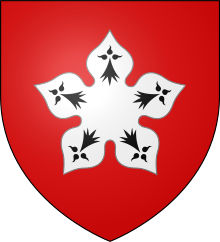Robert de Beaumont, 3rd Earl of Leicester (1121 - 1190), called Blanchemains,[1] was an English nobleman, one of the principal followers of Henry the Young King in the Revolt of 1173–1174 against his father King Henry II.
Robert de Beaumont, 3rd Earl of Leicester | |
|---|---|
 | |
| Earl of Leicester | |
| Monarchs | Henry II and Richard I |
| Personal details | |
| Born | 1121 Leicester, Leicestershire, England |
| Died | 1190 Dyrrachium on the Third Crusade |
| Spouse(s) | Petronilla de Grandmesnil, Countess of Leicester |
| Children |
|
| Parents |
|
Life
editRobert was the son of Amicia de Gael and Robert de Beaumont, 2nd Earl of Leicester,[2] a staunch supporter of Henry II, and he inherited from his father large estates in England and Normandy.
When the younger Henry revolted in April 1173, Robert went to his castle at Breteuil in Normandy. The rebels' aim was to take control of the duchy, but Henry II himself led an army to besiege the castle; Robert fled, and the Breteuil was taken on 25 or 26 September.
Robert went to Flanders, where he raised a large force of mercenaries, and landed at Walton, Suffolk, on 29 September 1173. He joined forces with Hugh Bigod, 1st Earl of Norfolk, and the two marched west, aiming to cut England in two across the Midlands and to relieve the king's siege of Robert's castle at Leicester. However, they were intercepted by the king's supporters and defeated at the Battle of Fornham near Fornham, near Bury St Edmunds, on 17 October.[3] Robert, along with his wife and many others, were taken prisoner.[4] Henry II took away the earl's lands and titles as well.
Robert remained in captivity until January 1177,[5] well after most of the other prisoners had been released. The king was in a strong position and could afford to be merciful; not long after his release Robert's lands and titles were restored, but not his castles. All but two of his castles had been destroyed (slighted), and those two (Montsorrel in Leicestershire and Pacy in Normandy) remained in the king's hands.
Robert had little influence in the remaining years of Henry II's reign, but was restored to favour by King Richard I of England. He carried one of the swords of state at Richard's coronation in 1189.[6] In 1190 Robert went on the Third Crusade to the Holy Land but he died at Dyrrachium in Albania on his return journey.[a]
Family
editRobert married Petronilla,[2] who was a daughter of William de Grandmesnil and great-granddaughter and eventual heiress to the English lands of Domesday baron, Hugh de Grandmesnil. They had:
- Robert,[2] who succeeded his father as Earl of Leicester;
- Roger,[2] who became Bishop of St Andrews in 1189;
- William,[2] possibly the ancestor of the House of Hamilton;[8][9]
- Amicia, who married Simon de Montfort (died 1188),[2] and whose son Simon subsequently became Earl of Leicester;
- Margaret, who married Saer de Quincy, later 1st Earl of Winchester[2]
Notes
editReferences
edit- ^ Hollister 2001, p. 173.
- ^ a b c d e f g Lemoine-Descourtieux 2011, p. 117.
- ^ Young 2018, p. 101.
- ^ Hays & Jones 1990, p. 308.
- ^ Bennett 2021, p. 105.
- ^ Jones 2023, p. 57.
- ^ Bennett 2021, p. 117.
- ^ Cowan,Vol I,p80
- ^ Balfour Paul Vol IV, p339
Sources
edit- Bennett, Stephen (2021). Elite Participation in the Third Crusade. Vol. 50. The Boydell Press.
- Hays, L.; Jones, E. D. (1990). "Policy on the Run: Henry II and Irish Sea Diplomacy". Journal of British Studies. 29 (4 (Oct.)). Cambridge University Press: 293–316.
- Hollister, C. Warren (2001). Henry I. Yale University Press.
- Jones, Robert W. (2023). A Cultural History of the Medieval Sword: Power, Piety and Play. The Boydell Press.
- Lemoine-Descourtieux, Astrid (2011). La Frontière normande de l'Avre: De la fondation de la Normandie à sa reunion au domaine royal (in French). Publication des Universites de Rouen et du Havre.
- Young, Francis (2018). Edmund: In Search of England's Lost King. I.B. Tauris.
- Ancestral Roots of Certain American Colonists Who Came to America Before 1700 by Frederick Lewis Weis; Lines 53-26, 53-27
- Balfour Paul, Sir James, Scots Peerage IX vols. Edinburgh 1907.[1]
- Cowan, Samuel, The Lord Chancellors of Scotland Edinburgh 1911. [2]